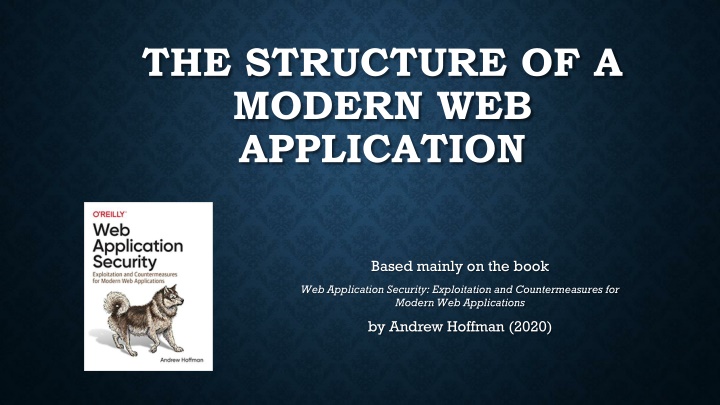
Modern Web Application Structure and Technologies Overview
Gain insights into the structure of modern web applications based on key technologies and their implementations. Explore the differences between modern and legacy web applications, delve into RESTful APIs, and understand the underlying frameworks and dependencies shaping web development today.
Download Presentation

Please find below an Image/Link to download the presentation.
The content on the website is provided AS IS for your information and personal use only. It may not be sold, licensed, or shared on other websites without obtaining consent from the author. If you encounter any issues during the download, it is possible that the publisher has removed the file from their server.
You are allowed to download the files provided on this website for personal or commercial use, subject to the condition that they are used lawfully. All files are the property of their respective owners.
The content on the website is provided AS IS for your information and personal use only. It may not be sold, licensed, or shared on other websites without obtaining consent from the author.
E N D
Presentation Transcript
THE STRUCTURE OF A MODERN WEB APPLICATION Based mainly on the book Web Application Security: Exploitation and Countermeasures for Modern Web Applications by Andrew Hoffman (2020)
UNDERSTANDING THE UNDERLYING TECHNOLOGIES To gain an understanding of the common technologies that many web applications share as dependencies. These dependencies span from JavaScript helper libraries and predefined CSS modules, all the way to web servers and even operating systems. By understanding the role of these dependencies and their common implementations in an applications stack, it becomes much easier to quickly identify them and look for misconfigurations. 2
MODERN VERSUS LEGACY WEB APPLICATIONS Web technologies advance fast. From server-side frameworks to client-side applications HTML/JavaScript/Cascading Style Sheet A page is updated by reloading. Ajax (asynchronous JavaScript and XML) allowing network requests to be made from within a page session via JavaScript Microservices vs monolithic applications An application is more represented as two or more applications/microservices communicating via a network protocol. 3
MODERN VERSUS LEGACY WEB APPLICATIONS (CONT.) Modern-day web applications probably make use of several of the following technologies: REST API JSON or XML JavaScript SPA framework (React, Vue, EmberJS, AngularJS) An authentication and authorization system One or more web servers (typically on a Linux server) One or more web server software packages (ExpressJS, Apache, NginX) One or more databases (MySQL, MongoDB, etc.) A local data store on the client (cookies, web storage, IndexDB) 4
RESTFUL APIS Representational State Transfer (REST) APIs Based on HTTP, JSON, XML Making it easy for the client app to request resources from the servers These APIs are stateless. To maintain state information (e.g., authorization), tokens are sent on every request. 5
RESTFUL APIS (CONT.) Each endpoint should define a specific object or method. To modify the moderator account : PUT /moderators/joe To delete the 12_21_2018 log: 6 DELETE /moderators/joe/logs/12_21_2018
RESTFUL APIS (CONT.) c.f., Simple Object Access Protocol (SOAP)-structured APIs REST requests target data, not functions. Easy caching of requests Highly scalable SOAP APIs must utilize XML as their in-transit data format; REST APIs can accept any data format, but typically JSON is used. (JSON is more lightweight and easier to read.) 7
JSON JavaScript Object Notation an open-standard (not proprietary) file format that meets a number of interesting requirements: is lightweight (reduces network bandwidth) requires very little parsing (reduces server/client hardware load) is easily human readable is hierarchical (can represent complex relationships between data) JSON objects are represented very similarly to JavaScript objects, making consumption of JSON and building new JSON objects quite easy in the browser. All major browsers today support the parsing of JSON natively. 8
SERVER-SIDE DATABASES SQL injection attacks is a well-known vulnerability archetype effective against major SQL databases when queries are not properly formed. Injection-style attacks can occur against almost any database if a hacker is willing to learn the database s query model. It is wise to consider that many modern web applications can employ multiple databases at the same time, and often do. Applications with sufficiently secure SQL query generation may not have sufficiently secure MongoDB or Elasticsearch queries and permissions. 9
CLIENT-SIDE DATA STORES Traditionally, minimal data is stored on the client because of technical limitations and cross-browser compatibility issues. Many applications now store significant application state on the client, often in the form of configuration data or large scripts that would cause network congestion if they had to be downloaded on each visit. In most cases, a browser-managed storage container called local storage is used for storing and accessing key/value data from the client. Local storage follows browser-enforced Same Origin Policy (SOP), which prevents other domains (websites) from accessing each other s locally stored data. Web applications can maintain state even when the browser or tab is closed. 10
LOCAL VS SESSION STORAGE A subset of local storage called session storage operates identically, but persists data only until the tab is closed. This type of storage can be used when data is more critical and should not be persisted if another user uses the same machine. 12
CLIENT-SIDE DATA STORES (CONT.) Browser support for IndexedDB is found in all major web browsers today. Usually for more complex applications IndexedDB is a JavaScript-based object oriented programming database capable of storing and querying asynchronously in the background of a web application. Because IndexedDB is queryable, it offers a much more powerful developer interface than local storage is capable of. IndexedDB finds use in web-based games and web-based interactive applications (like image editors). 13
CLIENT-SIDE DATA STORES (CONT.) Potential vulnerability In poorly architected web applications, client-side data stores may also reveal sensitive information such as authentication tokens or other secrets. 14
SUMMARY A modern web application is built on a number of technologies. It s essential to analyze an application s behavior from the perspective of a server, a client, or the network in between. (the three layers of a modern web application) 15
